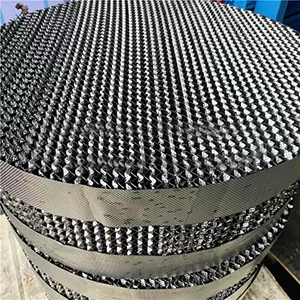How to Evaluate the Quality of structured packing?
Evaluating the quality of structured packing involves assessing multiple factors related to its material, design, manufacturing precision, and performance characteristics. High-quality structured packing should consistently deliver efficient mass transfer, durability, and reliability in industrial separation processes. Here are key criteria to consider:

Material Quality
The choice of material directly impacts performance and longevity. For metal structured packing, check for material purity and alloy composition—high-grade stainless steel, Hastelloy, or aluminum alloys should meet industry standards for corrosion resistance and mechanical strength. ceramic packing requires uniform sintering and low porosity to ensure resistance to high temperatures and chemical corrosion. plastic packing (e.g., PP, PTFE) should exhibit consistent thickness and freedom from cracks or impurities, with material certifications confirming resistance to chemicals and temperature extremes.
Structural Precision
High-quality structured packing features precise geometric uniformity. Inspect the corrugated sheets or meshes for consistent dimensions: corrugation height, angle (typically 30° or 45°), and spacing should match design specifications across the entire packing module. Irregularities such as uneven corrugations, bent edges, or misaligned layers can cause flow channeling, reducing mass transfer efficiency. The modules should also fit together tightly without gaps, ensuring stable installation and uniform gas-liquid distribution.
Surface Condition
The surface of the packing directly affects gas-liquid contact. For sheet-based packing, surfaces should be smooth but may include intentional textures (e.g., perforations, embossing) to enhance liquid spreading and turbulence—these features should be evenly distributed. Avoid packing with surface defects like pits, rust (for metal), or glaze cracks (for ceramic), as these can trap contaminants or disrupt flow patterns.
Performance Testing
Reliable manufacturers provide performance data from standardized tests, such as pressure drop per unit height and mass transfer efficiency (e.g., number of theoretical stages). High-quality packing should exhibit low pressure drop under design flow rates and consistent efficiency across a range of operating conditions. Certifications or third-party test reports can validate these claims, ensuring the packing meets performance expectations in real-world applications.
Durability and Resistance
Quality structured packing should withstand operational stresses. metal packing should resist deformation under high temperatures or pressure fluctuations. Ceramic packing must tolerate thermal shock without cracking. Plastic packing should maintain structural integrity over extended exposure to process fluids without swelling or degradation. Evaluating resistance to fouling—through material selection or surface treatments—is also critical, as durable packing minimizes maintenance needs.
Manufacturing Standards
Reputable manufacturers adhere to strict quality control during production, including precision cutting, forming, and assembly. Look for evidence of quality management systems (e.g., ISO certifications) and consistent batch-to-batch uniformity. Poorly manufactured packing may show signs of rough edges, inconsistent bonding (for layered designs), or incomplete sintering (for ceramic), all of which compromise performance.
In summary, assessing structured packing quality involves verifying material integrity, structural precision, surface condition, performance data, and manufacturing standards. High-quality packing ensures efficient, long-term operation in separation processes, making it a worthwhile investment for industrial applications.

